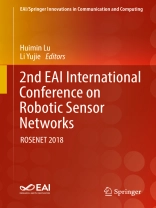This book provides scientific research into Cognitive Internet of Things for Smart Society, with papers presented at the 2nd EAI International Conference on Robotic Sensor Networks. The conference explores the integration of networks and robotic technologies, which has become a topic of increasing interest for both researchers and developers from academic fields and industries worldwide. The authors posit that big networks will be the main approach to the next generation of robotic research, with the explosive number of networks models and increasing computational power of computers significantly extending the number of potential applications for robotic technologies while also bringing new challenges to the network’s community. The 2nd EAI International Conference on Robotic Sensor Networks was held 25-26 August 2018 at the Kitakyushu International Conference Center (MICE), Kitakyushu, Japan.
Table of Content
Introduction.- Marine Organisms Tracking and Recognizing Using YOLO.- Group recommendation robotics based on external social-trust networks.- Energy-Efficient Virtual Machines Dynamic Integration for Robotics.- An Auction-based Task Allocation Algorithm in Heterogeneous Multi-robots System.- An introduction to formation control of UAV with Vicon System.- New tuning formulas: genetic algorithm used in air conditioning process with PID controller.- A multi-level thresholding image segmentation based on an Improved Artificial bee colony algorithm.- Dynamic Consolidation based on Kth-order Markov Model for Virtual Machines.- Research of adaptability evaluation of remote sensing image fusion method based on Nearest-neighbor diffusion pan sharpening.- Estimation of impervious surface distribution by linear spectral mixture analysis: a case study in Nantong, China.- Vehicle Logo Detection Based on Modified YOLOv2.- Multi-level Chaotic Maps for 3D Textured Model Encryption.- Blind Face Retrieval for Mobile Users.- Near-Duplicate Video Cleansing Method Based on LSH and SNM.- A Double Auction VM Migration Approach.- Non-uniformity Detection Method Based on Space Time Auto Regressive.- Secondary Filter Keyframes Extraction Algorithm Based on Adaptive Top-K.- Quadratic Discriminant Analysis Metric Learning Based on Feature Augmentation for Person Re-identification.- Weighted Linear Multiple Kernel Learning for Saliency Detection.- Conclusion.
About the author
Huimin Lu received a B.S. degree in Electronics Information Science and Technology from Yangzhou University in 2008. He received M.S. degrees in Electrical Engineering from Kyushu Institute of Technology and Yangzhou University in 2011. He received a Ph.D. degree in Electrical Engineering from Kyushu Institute of Technology in 2014. From 2013 to 2016, he was a JSPS research fellow (DC2, PD, and FPD) at Kyushu Institute of Technology. Currently, he is an Assistant Professor in Kyushu Institute of Technology and an Excellent Young Researcher of MEXT-Japan. His research interests include computer vision, robotics, artificial intelligence, and ocean observing.
Yujie Li received the B.S. degree in Computer Science and Technology from Yangzhou University in 2009. She received M.S. degrees in Electrical Engineering from Kyushu Institute of Technology and Yangzhou University in 2012, respectively. She received a Ph.D. degree from Kyushu Institute of Technology in 2015. From 2016 to 2017, she was a Lecturer in Yangzhou University. Currently, she is an Assistant Professor in Fukuoka University, Japan and JSPS Research Fellow in Kyushu Institute of Technology, Japan. Her research interests include computer vision, sensors, and image segmentation.












